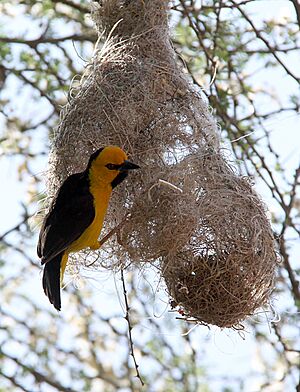Black-necked weaver facts for kids
Quick facts for kids Black-necked weaver |
|
|---|---|
 |
|
| Conservation status | |
| Scientific classification | |
| Genus: |
Ploceus
|
| Species: |
nigricollis
|
The black-necked weaver (Ploceus nigricollis) is a cool bird that lives in central Africa. You can find it in countries like Cameroon, Kenya, and southern Somalia. These birds are known for their weaving skills when building nests!
Contents
How Did the Black-necked Weaver Get Its Name?
A French bird expert, Louis Pierre Vieillot, first described this bird in 1805. He gave it the name Malimbus nigricollis. The name nigricollis comes from two Latin words. Niger means "black" and collis means "necked". This perfectly describes its black neck!
Different Types of Black-necked Weavers
There are two main types, or subspecies, of the black-necked weaver:
- P. n. nigricollis (Vieillot, 1805): This type lives from eastern Cameroon to southern Sudan. You can also find it in western Kenya, north-western Tanzania, and Angola. It even lives on the island of Bioko.
- P. n. melanoxanthus (Cabanis, 1878): This type is found in southern Ethiopia and southern Somalia. It also lives in central and eastern Kenya and north-eastern Tanzania.
The black-necked weaver was once thought to be the same as the olive-naped weaver. But scientists found they are different. They have different feathers and eye colors. Even though they look a bit alike, they are now known as separate species.
What Does the Black-necked Weaver Look Like?
The black-necked weaver is a strong, stocky bird about 16 cm (6 inches) long. It has a powerful, cone-shaped bill.
The adult male of the northern type has olive-green upper-parts and wings. Its belly and head are yellow. It has a black mask around its eyes and a black patch on its throat, like a bib. Its eyes are pale yellow. When it's not breeding, the male's head turns yellow with an olive top. Its upper-parts become grey, and its belly turns whitish. But its wings stay yellow and black.
The adult female also has olive-green upper-parts and wings. Her belly and head are yellow. She has a black mask around her eyes, but she doesn't have the black bib like the male.
The southern type of black-necked weaver looks quite different. It lives from Nigeria eastward. This type has almost black upper-parts and tail.
What Do They Eat and Sound Like?
Black-necked weavers eat both insects and plant material. Their calls sound like a wheezing dew-dew-twee.
Where Does the Black-necked Weaver Live?
This weaver bird lives in forests. They especially like wet areas within these forests.
How Does the Black-necked Weaver Live?
Black-necked weavers are amazing builders! They create a large, rough nest from grass and climbing plants. The nest has a round egg chamber. From this chamber, a 15 cm (6 inch) tunnel hangs down. This tunnel is the entrance to the nest.
They hang their nests from tree branches. Inside, the female lays 2 to 3 eggs. Black-necked weavers usually nest in pairs. But when they are not breeding, they often gather in small flocks.



